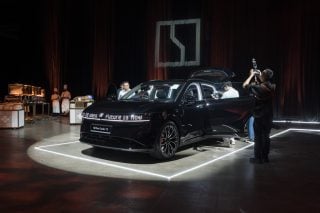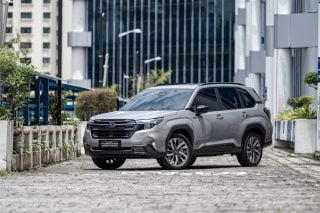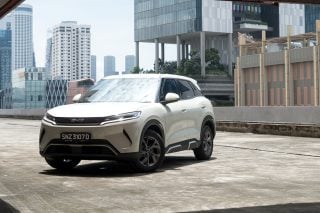If you’ve yet to get behind the wheel of a BYD, you might be wondering why the brand is so popular here. I could get into the technical details, but these are things that regular consumers aren’t interested in.
So, whenever I get car-related questions from friends, I always think carefully before replying to avoid overloading them with too much information. And I always end my reply with, “You’ll never know until you try.”
Here’s a confession, though: That line was never mine. It was said to me as a child whenever I was reluctant to try something for fear of a negative outcome. I’ve since learnt to give things a go before concluding whether I like something or not, and that applies to cars as well.

BYD Seal Dynamic.
THE “ENTRY-LEVEL” SEAL
BYD’s popularity here has nothing to do with offering the least-expensive EVs. But as with all cars, the first thing that draws one’s attention is its looks, so design undoubtedly plays a role.
Now, the Seal has been criticised as copying the design of the Porsche Taycan, but there’s no denying that it’s still a handsome and sporty-looking sedan. Indeed, BYD markets the Seal as an electric sports sedan.
It has a low-slung stance, steeply raked A-pillars, and just enough lines to add tension to its body panels and give it muscularity. Its styling also hints at its technology – LED headlights and tail-lamps are standard, the door handles pop out and retract as needed, and you can use an NFC card key instead of the fob to lock/unlock the car.

More importantly, despite being the entry-level version, there’s nothing about the Seal Dynamic that looks “basic”. You even get 18-inch wheels as standard and a diffuser below the rear bumper.
Nothing seems to have been pared from the cabin either. The sports seats are still there, along with a 10.25-inch instrument panel and massive 15.6-inch infotainment screen, officially called the Intelligent Rotating Touchscreen Display. It lets the driver use it in either landscape or portrait orientation, at a touch of a button.
Android users can enjoy wireless Android Auto, while Apple users have wireless CarPlay to mirror their phones. Although the test unit did not have wireless CarPlay, connecting my phone with a cable to the USB-A point by the driver’s side instantly remedied this.

DIESEL-LIKE NATURE
Turbo-diesel engines produce a lot of low-end torque, typically at just over tick-over, which makes them ideal for hauling heavy loads. Electric motors have the same characteristic, for the immediacy of their power delivery can make a car feel effortless.
That’s why it doesn’t matter that the Seal Dynamic has 134bhp and a zero to 100km/h time of 10 seconds. With 310Nm of torque, unchanged from when the Seal Dynamic was a Cat B model with 201bhp, the car feels quick enough off the line.
In fact, bury the accelerator pedal and your passengers may not believe the car only has 134bhp or that it takes 10 seconds to finish the century sprint. You can also tell them about the car’s 1.9-tonne mass and the lag when you step on the accelerator, but they’ll find that hard to believe, too.

What they will be impressed with is the Seal’s pillowy softness. Unlike the top-end Seal Performance, whose firm dampers make for a busy ride, the Seal Dynamic is gentle to a fault. It’s so pliant that you could fool others into thinking the car has air suspension.
With comfort-biased tyres, the Seal Dynamic goes over uneven surfaces and speed bumps with such ease that you feel like you’re riding in a car costing twice as much.
In fact, everything about the Seal is soft. The steering is light (both on effort and feel) and the pedals are mushy, too. It’s as if everything was designed to feel as easy as the drive. Another reason to rein in your enthusiasm is the snatchy brakes. You need to press the pedal gingerly to avoid sudden, jerky stops.

Ironically, the Seal Dynamic should perhaps have been marketed as the Seal Comfort, because it’s not the model that sets pulses racing. Yes, the acceleration feels punchy, but the overly pliant ride means it’ll just lean left and right when you push hard in corners.
I like the rear-wheel drive layout because it feels like the car is pushing you, whereas in a front-wheel drive car, you’re being pulled. But if you buy the Dynamic variant, you need to forget about the ‘sports sedan’ bit and just enjoy its gentleness.

THE SEAL TO HAVE?
If you’ve yet to drive a BYD and are still wondering what makes the brand so popular here, get behind the wheel of a Seal Dynamic and your questions will be answered.
In the Seal, you’ll find a well-sorted, rear-wheel drive sedan with plenty of standard kit. It has all the tech and safety features you’d expect from a modern EV, it rides well and is quick enough for daily driving. Plus, at under $200,000 (at time of writing), it’s relatively accessible, too.
If you’re still doubtful or hesitant, let it go or your curiosity will continue to haunt you. You’ll never know until you try.
This story was first published on Sgcarmart.
BYD Seal Dynamic (A)
MOTOR Permanent magnet synchronous
MAX POWER 134hp
MAX TORQUE 310Nm
GEARBOX Single-speed
POWER TO WEIGHT 69.7hp per tonne
0-100KM/H 10 seconds
TOP SPEED 180km/h
BATTERY 61.4kWh
RANGE 460km
CONSUMPTION 6.25km/kWh
PRICE INCL. COE From $192,888
AGENT E-Auto
Polestar 2 Standard Range Single Motor review: Stealth Power



















































